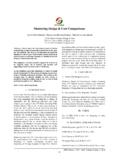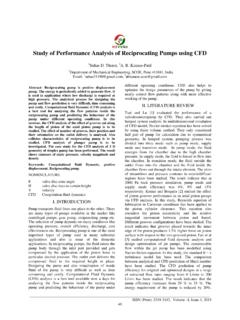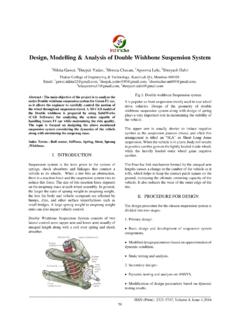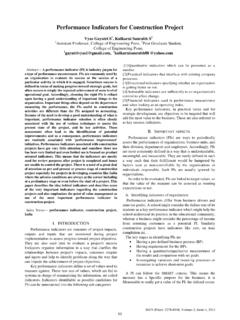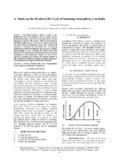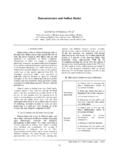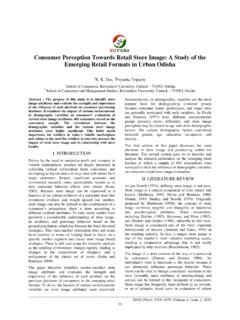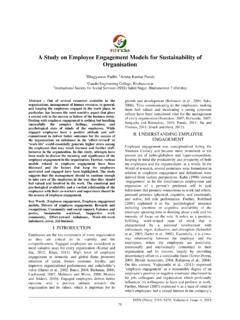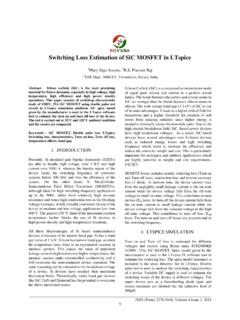Transcription of Application of Diamond Approach of Project …
1 International Journal of Recent Advances in Engineering & Technology ( ijraet ) _____ _____ ISSN (Online): 2347 - 2812, Volume-4, Issue -4, 2016 36 Application of Diamond Approach of Project Management Chaitaly Mayank Mehta Pro term lecturer Thakur College of Engineering and Technology, Kandivali, Mumbai, India Abstract A Project is a unique endeavour to produce a set of deliverables within clearly specified time, cost and quality constraints. Many factors decide the success of a Project like considering the time framework and budget of a Project .
2 Whereas on the other side the factors that lead to the failure of a Project are lack of experience, ignorance towards work etc. Therefore to avoid the failure of a Project efficient Project management is required. The need for Diamond Framework is realized here and has been explained in the following study Keywords Ntcp model, Diamond Approach . I. INTRODUCTION In addition, market globalization is forcing businesses to respond to local demands and to low-cost competition around the world. Moreover, the information technology (IT) and internet revolution is not slowing down.
3 Even in stable industries such as banking and insurance, organizations must continuously invest in new IT infrastructure to keep up with growing demand and competition. Each of these trends intensifies the Project activity in almost every organization and industry. These projects took place in different industries, were aimed at different markets, and used different technologies. Yet they had one thing in common. They all had highly talented and dedicated managers, the best professional teams, the latest Project management tools, and total support from top management.
4 It seemed that each of these projects had every ingredient to succeed, but all of them failed to meet their expectations; when managers finally understood what went wrong and why, it was too late to fix the problem. The common theme to all these failures was that they executives as well as the Project teams failed to appreciate up front the extent of uncertainty and complexity involved (or failed to communicate this extent to each other) and failed to adapt their management style to the situation. The Evolution of Project Types Along the Project Life Cycle This thesis considers strategic as well as the tactical aspects of Project performance in the short term as well as the long term.
5 To address differences among projects, a Diamond -shaped framework is offered to help managers distinguish among projects according to four dimensions: novelty, technology, complexity, and pace. The Diamond is designed to provide a disciplined tool for analyzing the expected benefits and risks of a Project and developing a set of rules and behaviors for each Project type. The Diamond analysis is also helpful in assessing a Project in midcourse, identifying possible gaps in a troubled Project , and selecting corrective actions to put the Project back on track.
6 THE Diamond NTCP MODEL NTCP Diamond Model The Diamond NTCP model is a structured framework that International Journal of Recent Advances in Engineering & Technology ( ijraet ) _____ _____ ISSN (Online): 2347 - 2812, Volume-4, Issue -4, 2016 37 managers can use when making decisions about projects and how they should be run. Each dimension includes three to four levels along a spectrum in which a Project might fall, as shown in figure. NOVELTY: HOW NEW IS THE PRODUCT TO THE MARKET. Product novelty is defined by how new the product is to its markets and potential users.
7 This dimension represents the extent to which customers are familiar with this kind of product, the way to use it, and that is, how clearly can you define the requirements and customer needs upfront. Product novelty includes three types: derivative, platform and breakthrough. The levels of the novelty are defined as follows: a) Derivative products are extensions and improvements of existing products. b) Platforms products are new generations of existing product lines. Such product replaces previous products in a well-established market sectors. A typical example is a new model of car.
8 C) Breakthrough products are new-to-world products. They transfer a new concept or a new idea into a new product that customers have never seen before. : TECHNOLOGICAL UNCERTAINTY The major sources of task uncertainty are technological uncertainty. Technological uncertainty has an impact on, among other things, design and testing, communication and interaction, the timing of design freeze, and the needed number of design cycles. It also affects the technical competence needed by the Project manager and Project members.
9 Four levels comprise technological uncertainty: a) Low tech projects: rely on existing and well established technologies. The most typical examples are construction projects. b) Medium tech projects use mainly existing or base technologies but incorporate a new technology or a new feature that did not exist in previous projects. c) High tech projects: represents situations in which most of the technologies employed are new to the firm. Super high- tech projects: are based on new technologies that do not exist at Project initiation. COMPLEXITY: THE COMPLEXITY OF A Project Simple way to define various levels of complexity is to use hierarchical framework systems.
10 Project complexity is directly related to system scope and affects Project and the formality of Project management. Three typical levels of complexity are used to distinguish among Project management practices: assembly, system and array. a) Assembly projects: involve creating a collection of elements, components and modules combined into a single unit or entity that performs a single function. b) System projects involve a complex collection of interactive elements and subsystems, jointly performing multiple functions to meet a specific operation need.
